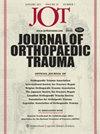Enoxaparin and Early Postoperative Tibial Nailing: Increased Nonunion Revision Rates
IF 1.6
3区 医学
Q3 ORTHOPEDICS
引用次数: 0
Abstract
To determine the association between postoperative enoxaparin use and the risk of requiring surgery for nonunion in patients treated with intramedullary nailing for midshaft fractures of the tibia. Design: Retrospective cohort analysis. Data were sourced from the PearlDiver national database. Patients were identified through the PearlDiver database by using CPT and ICD-10 codes. Included patients had undergone intramedullary nailing for midshaft fractures of the tibia between 2015 and 2020 and subsequently underwent revision surgery due to nonunion. The primary outcome measured in this study was rate of nonunion following intramedullary nailing for the different types of tibial shaft fractures (closed, Type I/ II open, Type III open). For each fracture subtype, the study compared nonunion rates between those who received enoxaparin in the postoperative period and those who did not receive enoxaparin at any time during the first six weeks postoperatively. Factors such as the timing and duration of enoxaparin therapy and demographic variables were also considered. The study included 16,986 patients, average age 49.2 years (SD 17.3); 43.1% were female. 574 patients required revision surgery for nonunion (3.4%). Among patients who did not receive enoxaparin, the nonunion rates were 1.6%, 3.9%, and 6.9% for closed, Type I/II open, and Type III open fractures. For patients who received enoxaparin within the first two weeks, the nonunion rates were 2.6%, 4.7%, and 7.9% for closed (RR = 1.67, p < 0.0001), Type I/II open (RR = 1.21, p < 0.0001), and Type III open (RR = 1.17, p = 0.355) fractures. Logistic regression confirmed enoxaparin was independently associated with nonunion (OR = 1.75, p = 0.0013 for closed fractures; OR = 1.51, p = 0.034 for Type I/II open fractures). Tobacco use was also a contributing factor (OR = 2.43, p < 0.0001 for closed fractures; OR = 2.00, p < 0.0001 for Type I/II open fractures; OR = 2.04, p = 0.0008 for Type III open fractures). The postoperative use of enoxaparin was associated with an elevated risk of nonunion in patients treated with intramedullary nailing for fractures of the tibial shaft. Prognostic Level III. See Instructions for Authors for a complete description of levels of evidence.依诺肝素与术后早期胫骨钉:增加非愈合翻修率
目的:确定胫骨中轴骨折髓内钉治疗患者术后使用依诺肝素与因不愈合而需要手术治疗的风险之间的关系。 设计:回顾性队列分析。 数据来源于 PearlDiver 国家数据库。 使用 CPT 和 ICD-10 编码通过 PearlDiver 数据库识别患者。纳入的患者在 2015 年至 2020 年期间因胫骨中轴骨折接受了髓内钉治疗,随后因不愈合接受了翻修手术。 本研究测量的主要结果是不同类型胫骨中轴骨折(闭合性、I/II型开放性、III型开放性)髓内钉术后的不愈合率。针对每种骨折亚型,该研究比较了术后接受依诺肝素治疗者与术后六周内任何时候均未接受依诺肝素治疗者的不愈合率。研究还考虑了依诺肝素治疗的时间和持续时间以及人口统计学变量等因素。 研究共纳入了 16986 名患者,平均年龄为 49.2 岁(SD 17.3);43.1% 为女性。574名患者(3.4%)因骨不连而需要进行翻修手术。在未接受依诺肝素治疗的患者中,闭合性骨折、I/II型开放性骨折和III型开放性骨折的不愈合率分别为1.6%、3.9%和6.9%。在头两周内接受依诺肝素治疗的患者,闭合性骨折(RR = 1.67,P < 0.0001)、I/II型开放性骨折(RR = 1.21,P < 0.0001)和III型开放性骨折(RR = 1.17,P = 0.355)的不愈合率分别为2.6%、4.7%和7.9%。逻辑回归证实依诺肝素与骨折不愈合独立相关(闭合性骨折 OR = 1.75,p = 0.0013;I/II 型开放性骨折 OR = 1.51,p = 0.034)。吸烟也是一个诱因(闭合性骨折 OR = 2.43,p < 0.0001;I/II 型开放性骨折 OR = 2.00,p < 0.0001;III 型开放性骨折 OR = 2.04,p = 0.0008)。 术后使用依诺肝素与胫骨干骨折髓内钉治疗患者的不愈合风险升高有关。 预后III级。有关证据等级的完整描述,请参阅 "作者须知"。
本文章由计算机程序翻译,如有差异,请以英文原文为准。
求助全文
约1分钟内获得全文
求助全文
来源期刊

Journal of Orthopaedic Trauma
医学-运动科学
CiteScore
3.90
自引率
8.70%
发文量
396
审稿时长
3-8 weeks
期刊介绍:
Journal of Orthopaedic Trauma is devoted exclusively to the diagnosis and management of hard and soft tissue trauma, including injuries to bone, muscle, ligament, and tendons, as well as spinal cord injuries. Under the guidance of a distinguished international board of editors, the journal provides the most current information on diagnostic techniques, new and improved surgical instruments and procedures, surgical implants and prosthetic devices, bioplastics and biometals; and physical therapy and rehabilitation.
 求助内容:
求助内容: 应助结果提醒方式:
应助结果提醒方式:


